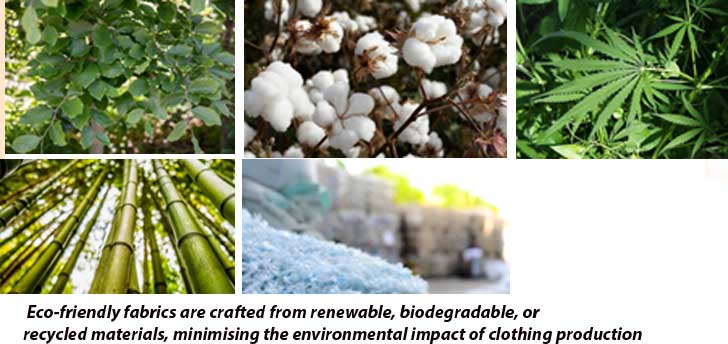
The emergence of eco-friendly fabrics
Consumer education and behaviour change are essential for fostering a culture of sustainability that transcends fleeting trends, states Amrit Sethia
In an era marked by heightened environmental consciousness, the fashion industry is undergoing a significant transformation. The traditional approach to clothing production, which often prioritised profit over sustainability, is giving way to a more eco-conscious ethos. Central to this shift is the emergence of eco-friendly fabrics, offering a promising path towards a more sustainable future for fashion.
The need for change
The conventional fashion industry has long been associated with environmental degradation and exploitation of resources. From water pollution to deforestation and hazardous chemical use, the environmental footprint of clothing production is substantial. Additionally, the industry’s reliance on non-renewable resources exacerbates the problem of resource depletion. With consumers increasingly demanding accountability from brands, the pressure to adopt sustainable practices has never been greater.
Embracing eco-friendly fabrics
Enter eco-friendly fabrics, heralding a new era of sustainable fashion. These fabrics are crafted from renewable, biodegradable, or recycled materials, minimizing the environmental impact of clothing production. From organic cotton and hemp to bamboo and recycled polyester, the options for eco-conscious consumers are expanding rapidly.
Modal: Modal fabric, a bio-based material made from beech tree cellulose, is an eco-friendly alternative to cotton. Beech trees require minimal water, making the production process 10-20 times more water-efficient. This light, airy fabric has a silky, breathable texture, making it an excellent choice for summer wardrobes. Its comfort and safety make it ideal for those with allergies or sensitive skin, and is much easier to care for. This semi-synthetic fiber is derived from beech tree pulp. Beech trees, like bamboo, are self-seeding and a renewable resource. Modal fabric has become a popular choice of fabric for lingerie, nightwear in the apparel industry and leading brands including SOIE amongst many others are embracing this trend with a range of products in the Modal Fabric collection.

Modal fabric is light and has breathable texture
Organic cotton: Unlike conventional cotton, which relies heavily on pesticides and synthetic fertilizers, organic cotton is grown using natural methods that promote soil health and biodiversity. By eschewing harmful chemicals, organic cotton cultivation reduces water consumption and prevents soil contamination, making it a more sustainable choice for clothing production.
Hemp: Hemp is a versatile and eco-friendly fibre that requires minimal water and pesticides to grow. Renowned for its durability and breathability, hemp fabric is well-suited for a wide range of clothing applications. Moreover, hemp cultivation can help mitigate deforestation and soil erosion, making it an environmentally responsible choice for fashion brands.

Hemp fabric is used for anti UV clothing, making it highly suitable for various outdoor activities.
Bamboo: Bamboo fabric, derived from the fast-growing bamboo plant, is gaining popularity for its sustainability credentials. Bamboo cultivation requires little water and no pesticides, making it a highly renewable resource. Additionally, bamboo fabric possesses natural antibacterial properties and is biodegradable, further enhancing its eco-friendly appeal.
Recycled polyester: Conventional polyester, derived from non-renewable fossil fuels, is a major contributor to environmental pollution. However, recycled polyester offers a sustainable alternative by repurposing post-consumer plastic waste into high-quality fabric. By diverting plastic from landfills and reducing the need for virgin polyester production, recycled polyester helps mitigate the environmental impact of clothing manufacturing.

Recycled polyester fabric is often more affordable compared to many sustainable materials.
Driving sustainable innovation
The rise of eco-friendly fabrics has catalysed a wave of innovation within the fashion industry. Brands are increasingly investing in research and development to explore new materials and production methods that minimise waste and environmental harm. From bio-based textiles made from agricultural by-products to closed-loop manufacturing processes that recycle water and chemicals, sustainable fashion is at the forefront of technological advancement. Furthermore, consumer awareness and demand play a crucial role in driving the adoption of eco-friendly fabrics. As more individuals prioritise sustainability in their purchasing decisions, brands are compelled to align with these values or risk losing relevance in the market. Social media and digital platforms have become powerful tools for raising awareness about sustainable fashion practices and holding brands accountable for their environmental impact.
The road ahead
While the emergence of eco-friendly fabrics represents a significant step towards a more sustainable fashion industry, challenges remain on the path to widespread adoption. Issues such as supply chain transparency, labour rights, and affordability pose ongoing hurdles for brands seeking to integrate sustainable practices into their operations. Moreover, consumer education and behaviour change are essential for fostering a culture of sustainability that transcends fleeting trends. As we look to the future, collaboration and collective action will be key to realising the vision of a truly sustainable fashion ecosystem. From designers and manufacturers to policymakers and consumers, each stakeholder has a role to play in advancing the cause of environmental responsibility in fashion. By embracing eco-friendly fabrics and adopting holistic sustainability practices, the industry can pave the way for a brighter, more resilient future—one where fashion is not only stylish but also ethical and eco-conscious.
In conclusion
The emergence of eco-friendly fabrics marks a pivotal moment in the evolution of the fashion industry. By prioritising sustainability and innovation, brands have the opportunity to redefine the norms of clothing production and consumption. As we navigate the complexities of a rapidly changing world, the embrace of eco-friendly fabrics offers hope for a more sustainable future—one where fashion is not just a reflection of style but also a catalyst for positive environmental change.
About the author:

Amrit Sethia is the Vice President of SOIE – Ginza Industries. SOIE, a distinguished brand that provides a comprehensive selection of lingerie, active wear, swimwear, and sleepwear for women, ranging from premium to basic, has been distinguished by a multitude of accomplishments including streamlining operations, increasing productivity, and establishing itself as a top brand.




